Concerning Syntax
 |
|
| Aaron Shaw & Rachel Shallit — June 2004 | |
 | Theoretical Articles: A comprehensive knowledge of the works of J.R.R. Tolkien is needed to fully understand articles in this category, the subjects treated being studied in minute detail by their authors. |
|---|---|
 he biggest problem encountered in formulating a description of Sindarin syntax is the same as that encountered in describing most other aspects of this language: there is simply not enough data for any deduced rule to be much more than speculation. Nevertheless, looking at this language from a syntactic point of view, instead of the diachronic phonological one that is more commonly taken, may provide scholars with some fresh insights on familiar issues. The syntactic framework used here will be the so-called “X-bar” theory, which proposes that all phrases have the same basic structure: all phrases must have one head, may have one specifier, and may have one complement. They are grouped together in this way:
he biggest problem encountered in formulating a description of Sindarin syntax is the same as that encountered in describing most other aspects of this language: there is simply not enough data for any deduced rule to be much more than speculation. Nevertheless, looking at this language from a syntactic point of view, instead of the diachronic phonological one that is more commonly taken, may provide scholars with some fresh insights on familiar issues. The syntactic framework used here will be the so-called “X-bar” theory, which proposes that all phrases have the same basic structure: all phrases must have one head, may have one specifier, and may have one complement. They are grouped together in this way:
| In this diagram and the following one, W, X, Y and Z stand for any syntactic category, such as noun or verb. |
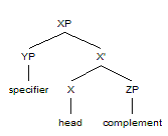
 anguages differ in the relative order of the head and complement (head-initial vs. head-final) and in the relative order of the specifier and X’ (the X’ level is also known as intermediate projection). Most languages are specifier-initial, but head-initiality and head-finality are found about equally often (and some languages have instances of both). English is a head-initial language; Japanese is head-final; some categories in German are head-initial while others are head-final.
anguages differ in the relative order of the head and complement (head-initial vs. head-final) and in the relative order of the specifier and X’ (the X’ level is also known as intermediate projection). Most languages are specifier-initial, but head-initiality and head-finality are found about equally often (and some languages have instances of both). English is a head-initial language; Japanese is head-final; some categories in German are head-initial while others are head-final.
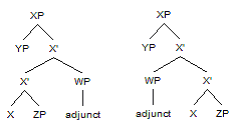
As well as head, specifier and complement, phrases may also contain one or more adjuncts, which attach at the X’ level. In the process of adjunction, the X’ node is cloned and the adjunct attaches to the right or left of the higher X’ node. (Right- and left-adjunction are both allowed; which is preferred depends on the language and the word/phrase in question.) There is much more to the X’ model of syntactic theory than this brief summary; interested readers may learn more from the excellent free textbook The Syntax of Natural Language, available here.
Basic Word Order and Parameter Settings
 ne of the most fundamental inquiries into a language’s syntax is what the basic word order of sentences is (meaning the relative ordering of subject, verb/predicate, and object). To arrive at a basic word order for Sindarin, we must consider the attested examples of finite matrix1) clauses with overt subjects:
ne of the most fundamental inquiries into a language’s syntax is what the basic word order of sentences is (meaning the relative ordering of subject, verb/predicate, and object). To arrive at a basic word order for Sindarin, we must consider the attested examples of finite matrix1) clauses with overt subjects:
Transitive examples
| SVO | VSO | Apparently SOV |
|---|---|---|
| Celebrimbor o Eregion teithant i thiw hin2) | aníra i aran… suilannad mhellyn în3) | Im Narvi hain echant4) |
| Aragorn… anglennatha i Varanduiniant5) | Arphent Rian Tuorna, Man agorech?6) | |
| e aníra ennas suilannad mhellyn în phain7) | ||
| e aníra tírad i Cherdir Perhael8) | ||
| A Rian pent, [Man agorech?] (crossed out)9) |
Intransitive examples
| SV | VS |
|---|---|
| Guren bêd enni10) | Tôl acharn11) |
| Ir Ithil… síla (poetry)12) | silivren penna… aglar elenath (poetry)13) |
| le linnon im Tinúviel (poetry)14)15) |
 s in Romance pro-drop languages such as Italian and Spanish, VS(O) and SV(O) orders are both seen; our small corpus does not give conclusive evidence as to which is basic, but judging by the number of examples, in transitive sentences SVO seems to be preferred. About intransitive sentences nothing can be said with certainty; however, the example guren bêd enni may suggest that VS is preferred. (This example will be discussed later.)
s in Romance pro-drop languages such as Italian and Spanish, VS(O) and SV(O) orders are both seen; our small corpus does not give conclusive evidence as to which is basic, but judging by the number of examples, in transitive sentences SVO seems to be preferred. About intransitive sentences nothing can be said with certainty; however, the example guren bêd enni may suggest that VS is preferred. (This example will be discussed later.)
The verb preceding the object equates to head-initiality of verb phrases, and this correlates with the head-initiality of other phrases (for example, languages with VO order usually have prepositions rather than postpositions and auxiliaries preceding verbs). Sindarin does appear to be consistently head-initial; verbs precede objects, articles precede nouns, and we see prepositions rather than postpositions.
The apparent SOV word order in Im Narvi hain echant is puzzling when viewed alongside the rest of the examples, except for the fact that hain is an accusative pronoun, and it would in fact not be unprecedented for these to procliticize on finite verbs16)17). This phenomenon is also found in the Romance languages; it is not at all exotic. The fact that Sindarin verbs have rich subject agreement suggests that verb movement18) should occur. The attestation of VS(O) word order confirms that it must; the following diagrams will make it clear why this is so.
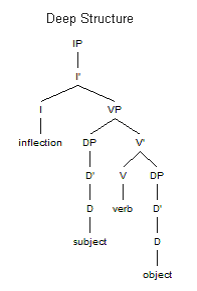
 his is how both a simple English sentence such as ‘The man ate the food’ and the Sindarin equivalent of that sentence theoretically appear before any movement occurs. In English, verb movement does not occur19), and the subject must move to the specifier of IP because that specifier must always be filled; that yields SVO word order. In Sindarin, VSO word order can only be derived by means of verb raising – the verb moves while the subject does not. (This is the standard method of analyzing VSO word order in the Celtic languages.)
his is how both a simple English sentence such as ‘The man ate the food’ and the Sindarin equivalent of that sentence theoretically appear before any movement occurs. In English, verb movement does not occur19), and the subject must move to the specifier of IP because that specifier must always be filled; that yields SVO word order. In Sindarin, VSO word order can only be derived by means of verb raising – the verb moves while the subject does not. (This is the standard method of analyzing VSO word order in the Celtic languages.)
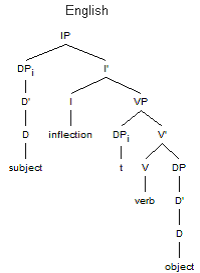
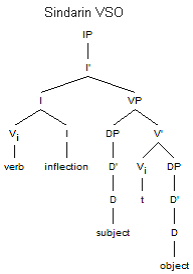
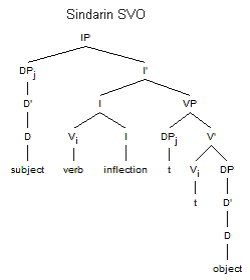
The presence of verb movement suggests that it is grammatical for an adverb to come between a verb and its object in Sindarin, as it is in, for example, French and Spanish. Whether these sentences are permitted is indeed the usual way of determining the setting of the verb movement parameter; unfortunately, we have no example of such a sentence20).
Head-final Determiners?
 s the reader may know, possessives and demonstratives in English are analyzed syntactically as determiners (they certainly cannot coexist with other determiners; ‘my house’ and ‘this house’ are grammatical, and ‘my the house’ and ‘the this house’ are not). So what shall we make of the apparent coexistence of two determiners in the same phrase in i eneth lín21) and i thiw hin22), or apparent head-finality of determiners in bess dîn and guren?
s the reader may know, possessives and demonstratives in English are analyzed syntactically as determiners (they certainly cannot coexist with other determiners; ‘my house’ and ‘this house’ are grammatical, and ‘my the house’ and ‘the this house’ are not). So what shall we make of the apparent coexistence of two determiners in the same phrase in i eneth lín21) and i thiw hin22), or apparent head-finality of determiners in bess dîn and guren?
We will begin by looking at the structure of the 1st person singular possessive suffix, found only in the body part terms lammen23) and guren24). It cannot just be declared head-final; for determiners to be head-initial in some cases but head-final in others is quite irregular. Also, the process of suffixation must reflect a syntactic derivation; i.e. head movement must occur to join the noun and determiner. Based on general principles of syntax, the noun raising is the preferred analysis25):
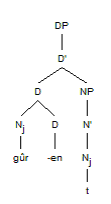
This structure predicts that an adjective should not be able to be placed before a noun with a possessive suffix on it. (Normally, adjectives are not placed before nouns in Sindarin – we have only one example of this happening, galadhremmin ennorath – but the grammaticality of this structure is still relevant.)
The corpus provides very little evidence to either support or disprove this analysis. However, this analysis is adopted in this article not only because of the relevant principle of syntactic theory, but also because of the existence of this type of movement in other languages. In Italian, this type of movement occurs with proper names: when a proper name is not preceded by an overt determiner, the name moves to D, as shown by the ungrammaticality of placing an adjective before it. Similarly, in Bulgarian, articles are suffixes. Normally, adjectives precede the nouns they modify, but when a noun has a suffixed article the order is suddenly noun-adjective, showing that the noun moves to D to join with the suffix. (Readers who recognize the parallels between N-to-D movement and verb raising are quite right.)
The possessives and demonstratives that appear with the article i may be analyzed in a quick and obvious way: as syntactically adjectives rather than determiners. There is in fact a bit of evidence for this analysis, instead of a more complicated one wherein these words are some form of clitic. The Lord’s Prayer contains the phrase i mbas ilaurui vín26); vín is lenited as postnominal adjectives normally are (see sui mín in the same text for the unlenited form), and the adjective ilaurui comes between it and the noun. It is not hard to imagine vín as the second in a set of two adjuncts:
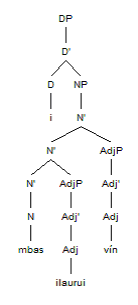
 here remain the possessives that are similar to nín, lín, and vín but do not appear with an article. (These have several characteristics in common: they all are found in the King’s Letter, have circumflexed vowels, and are third person forms. Which common characteristics are relevant, if any, remains unclear.) There are several possibilities for the structure of these and the reasons for their existence; none is overwhelmingly convincing. These possessives may have the same structure as the possessive suffixes; this construction could be some type of genitival construction (sellath dîn could mean ‘daughters [of] him’ or ‘daughters [of] his’); the article could be dropped in these examples because all the possessed nouns are kinship or relational terms (a similar phenomenon is found in Italian). There is some support for the first structure; that is the example of mhellyn în phain. While it seems somewhat peculiar that a quantifier like “all” would be placed in such a position, this analysis may account for the facts:
here remain the possessives that are similar to nín, lín, and vín but do not appear with an article. (These have several characteristics in common: they all are found in the King’s Letter, have circumflexed vowels, and are third person forms. Which common characteristics are relevant, if any, remains unclear.) There are several possibilities for the structure of these and the reasons for their existence; none is overwhelmingly convincing. These possessives may have the same structure as the possessive suffixes; this construction could be some type of genitival construction (sellath dîn could mean ‘daughters [of] him’ or ‘daughters [of] his’); the article could be dropped in these examples because all the possessed nouns are kinship or relational terms (a similar phenomenon is found in Italian). There is some support for the first structure; that is the example of mhellyn în phain. While it seems somewhat peculiar that a quantifier like “all” would be placed in such a position, this analysis may account for the facts:
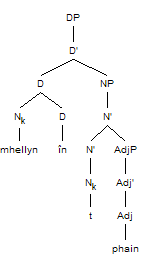
The main reason for this analysis is the apparent nasal mutation on the word #pain; nasal mutation is caused by the determiner in in all other examples, and the affected word is part of the determiner’s complement. If #pain were the head of an apparently head-final quantifier phrase, we would have a quite unprecedented example of a word causing mutation on another word that asymmetrically c-commanded27) it. Alternatively, the structure of the possessive could be the same, but phain could be the head of a head-initial quantifier phrase (as “all” is in English), and its placement could be explained by further movement. Nasal mutation could be explained by the fact that phain is part of a complex head; another example of mutation within a complex head is lenition after the negation ú-.
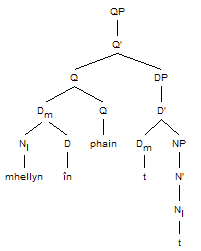
 he reason that these forms appear may be that the third person singular pronominal ending #-s was lost and that what were previously adjectives began to be used in place of the suffixes. The distinction between this construction and the construction with adjectival possessives could then have been lost in the third person singular. (Whatever the semantic difference between possessive endings and possessive adjectives is, it seems likely that if the two forms in question were, for example, #i sellath dín and sellath dîn, they could easily have become conflated.)
he reason that these forms appear may be that the third person singular pronominal ending #-s was lost and that what were previously adjectives began to be used in place of the suffixes. The distinction between this construction and the construction with adjectival possessives could then have been lost in the third person singular. (Whatever the semantic difference between possessive endings and possessive adjectives is, it seems likely that if the two forms in question were, for example, #i sellath dín and sellath dîn, they could easily have become conflated.)
Another possible explanation is that #i sellath dín could have been the normal way to say ‘his daughters’ in Sindarin, and the construction described above could have been part of the dialect of Gondor (since it is only found in the King’s Letter). Sindarin usage in Gondor could have been strongly influenced by Westron. One of the few things currently known about Westron grammar is that articles are suffixes; possessives could be so as well, and Sindarin’s possessive adjectives could have been confused for suffixes by those in Gondor who used Sindarin28). Another possibility may of course be that Tolkien only decided on such forms as i eneth lín, with an article present, after the composition of the King's Letter; the King's Letter is an early source, classified as late Noldorin rather than Sindarin.
Syntactic Influences on the Consonant Mutations
 onsonant mutations seem to be triggered in certain specific environments. The environments known or deduced are when a noun follows an article, a noun follows a preposition, a noun is the direct object of a verb29), an adjective follows a noun, or a word follows a relative pronoun (this last rule seems to be inconsistently applied). The relations on this list may seem not to have much in common. However, this may not be an ad hoc set of rules; all of these relations except the last two are head-complement relations (a head triggers mutation on the first phonologically overt word in its complement).
onsonant mutations seem to be triggered in certain specific environments. The environments known or deduced are when a noun follows an article, a noun follows a preposition, a noun is the direct object of a verb29), an adjective follows a noun, or a word follows a relative pronoun (this last rule seems to be inconsistently applied). The relations on this list may seem not to have much in common. However, this may not be an ad hoc set of rules; all of these relations except the last two are head-complement relations (a head triggers mutation on the first phonologically overt word in its complement).
Lenition of following adjectives is different from the other mutation conditions in that the words that undergo mutation are adjuncts, not complements. One of the ways that adjunction is different from other relations is that multiple adjunction is allowed, and we indeed seem to see lenition of multiple adjectives in i mbas ilaurui vín. This type of lenition seems to be best described as NP-internal lenition, since the rule does not seem to be extended to verbs and adverbs (e.g. in silivren penna míriel and le nallon sí).
Mutation after a relative pronoun seems not to fit with the other examples in a different way. Relative pronouns are found in the specifier of CP, and the embedded clause is the complement of a silent complementizer (in English relative clauses, also the relative pronoun, or in some cases both the relative pronoun and the complementizer, can be silent). The specifier-silent head-complement relation causing mutation seems unprecedented. The fact that this mutation seems optional is also puzzling. Here follow attested Sindarin relative clauses, organized by the mutation that the relative pronoun causes. If there is a pattern to this, it is not apparent:
| No mutation | Lenition | Nasal mutation |
|---|---|---|
| Perhael, i sennui Panthael estathar aen30) | Dor Firn i guinar31) | Dor Gyrth i chuinar32) |
| sui mín i gohenam33) | di ai gerir úgerth ammen34) | |
| Ae Adar nín i vi Menel35) |
 here is a possible solution that would both bring this back in line with the rest of the mutation-causing relations and provide an explanation for the fact that this mutation is apparently optional; however, it is not without its problems. The relative pronoun could be homophonous with a complementizer, and this complementizer could cause mutation while the relative pronoun did not. The complementizer would have to display agreement, which is not unheard of in the world’s languages; however, the relative pronoun would have to not display agreement. It seems unlikely that a complementizer would display agreement while a relative pronoun did not.
here is a possible solution that would both bring this back in line with the rest of the mutation-causing relations and provide an explanation for the fact that this mutation is apparently optional; however, it is not without its problems. The relative pronoun could be homophonous with a complementizer, and this complementizer could cause mutation while the relative pronoun did not. The complementizer would have to display agreement, which is not unheard of in the world’s languages; however, the relative pronoun would have to not display agreement. It seems unlikely that a complementizer would display agreement while a relative pronoun did not.
There is one piece of evidence that shows that i may be a complementizer: the Quenya word nai ‘may it be’ or ‘be it that’, which is commonly analyzed as na “be” + i “that”. If this is indeed the correct derivation, i must have been a complementizer at some stage in the evolution of Quenya. However, it may be simpler to see the variation in mutation in relative clauses as merely Tolkien’s revision of his languages. The many variants of the name of the ‘Land of the Dead that Live’ (of which the best known is probably Dor Firn i guinar from The Silmarillion) show alternatingly no mutation, lenition, and nasal mutation – quite possibly reflecting Tolkien’s changing opinion on what mutation the relative pronoun may cause.
Lenition as a Syntactic Marker?
 long with these fairly well understood mutation conditions, there are also instances of lenition that do not fall into any well-defined category and have remained obscure to scholars. These examples include bêd (lenited from pêd) in guren bêd enni, hi (lenited from si) in edro hi ammen, and díriel (lenited from tíriel) in Ir Ithil ammen Eruchîn menel-vîr síla díriel. There have been attempts to explain lenition here: lenition of si is most commonly explained by some theory of “imperative lenition”, in which anything after an imperative is lenited. Lenition of pêd is often explained by a theory that verbs immediately after their subjects are lenited. (The present writer is not familiar with any widely accepted theory about the lenition of tíriel.)
long with these fairly well understood mutation conditions, there are also instances of lenition that do not fall into any well-defined category and have remained obscure to scholars. These examples include bêd (lenited from pêd) in guren bêd enni, hi (lenited from si) in edro hi ammen, and díriel (lenited from tíriel) in Ir Ithil ammen Eruchîn menel-vîr síla díriel. There have been attempts to explain lenition here: lenition of si is most commonly explained by some theory of “imperative lenition”, in which anything after an imperative is lenited. Lenition of pêd is often explained by a theory that verbs immediately after their subjects are lenited. (The present writer is not familiar with any widely accepted theory about the lenition of tíriel.)
There are counterexamples to both of these proposed rules. “Imperative lenition” is contradicted by si loth a galadh lasto dîn (assuming that dîn means “silent[ly]” or “silence”) and the recently published sentence tiro men di ngorgoros. The rule about verbs following their subjects being lenited is contradicted by Celebrimbor o Eregion teithant i thiw hin and A Rian pent [Man agorech?]. Of course, there are counterexamples to many widely accepted rules formulated about Sindarin grammar, but here the counterexamples seem to outnumber the sentences that suggested the rules.
When these examples are looked at in a syntactic light, an alternative, more general solution suggests itself: words may be lenited as a marker of abnormal word order. Possible reasons for each instance of lenition are as follows. Hi in edro hi ammen obviously adjoins at V’ since it is followed by another adjunct which must adjoin at V’, a prepositional phrase:
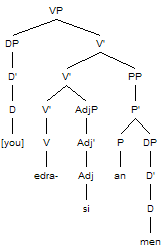
 owever, in English, the adverb “now” prefers to adjoin higher in the sentence: a sentence like ‘Bill is walking now with his friends’ sounds much less natural than ‘Bill is walking with his friends now.’ (‘Bill is walking now quickly’ is, if not ungrammatical, nearly so; the strict ordering of adverbs is a topic investigated by quite a few syntacticians.) There may be a similar rule about the adverb si in Sindarin, but here it must adjoin at V’ because of the rhythm and rhyme scheme of the poem it is found in (cf. Anno ammen sír36)).
owever, in English, the adverb “now” prefers to adjoin higher in the sentence: a sentence like ‘Bill is walking now with his friends’ sounds much less natural than ‘Bill is walking with his friends now.’ (‘Bill is walking now quickly’ is, if not ungrammatical, nearly so; the strict ordering of adverbs is a topic investigated by quite a few syntacticians.) There may be a similar rule about the adverb si in Sindarin, but here it must adjoin at V’ because of the rhythm and rhyme scheme of the poem it is found in (cf. Anno ammen sír36)).
Tíriel may be lenited for a similar reason. The translation adopted here of the sentence in question is ‘Having watched when the Moon, sky-jewel, shines for us, the Children of Eru, now, flower and tree, listen silently!’37) In English, adjuncts with “when” overwhelmingly prefer to right-adjoin, not left-adjoin; as before, this rule could also apply in Sindarin but be broken here because of the rhyme scheme of this poem38). The lenition of pêd in guren bêd enni is almost certainly not due to some close association between the subject and the verb; in other languages, verb-object, not subject-verb, is the relation for which this type of phenomenon is found. Rather, lenition could be caused by unusual word order here – but what is the unusual word order?
The difference between the two sentences without verbal lenition cited above and this sentence is evidently transitivity – and tôl acharn, with VS order, is the only other prose example of an intransitive finite matrix clause with an overt subject besides this sentence. It is possible that Sindarin subjects do not prefer to move to the specifier of IP, but that the presence of a direct object somehow increases the probability of subject movement. In intransitive sentences, if the subject does move, this non-preferred word order may be marked by verbal lenition.
Conclusion
 he fact that almost everything stated here is hypothetical cannot be overemphasized; deducing syntactic rules about a whole language from this little data is not generally a wise practice, and further publications may disprove much of what is stated here. However, the picture of Sindarin syntax presented here seems to be both logically consistent and a good description of the facts.
he fact that almost everything stated here is hypothetical cannot be overemphasized; deducing syntactic rules about a whole language from this little data is not generally a wise practice, and further publications may disprove much of what is stated here. However, the picture of Sindarin syntax presented here seems to be both logically consistent and a good description of the facts.
The syntax of Tolkien’s languages, compared with the phonology, has been studied far too little; more discussion on this topic would be most welcome. If any readers wish to discuss or argue with something stated here, we encourage them to carry out this investigation and to share their findings with the linguistic community.
See also on Tolkiendil
-
- Le doriathrin : la langue maternelle de Lúthien [in French]








